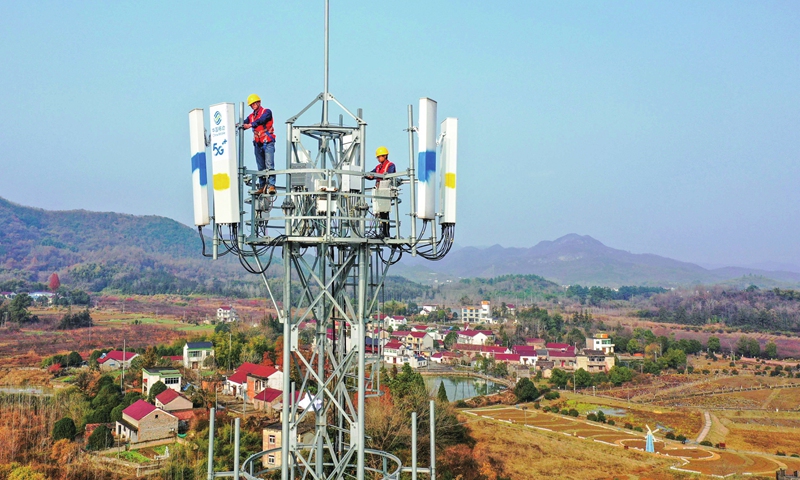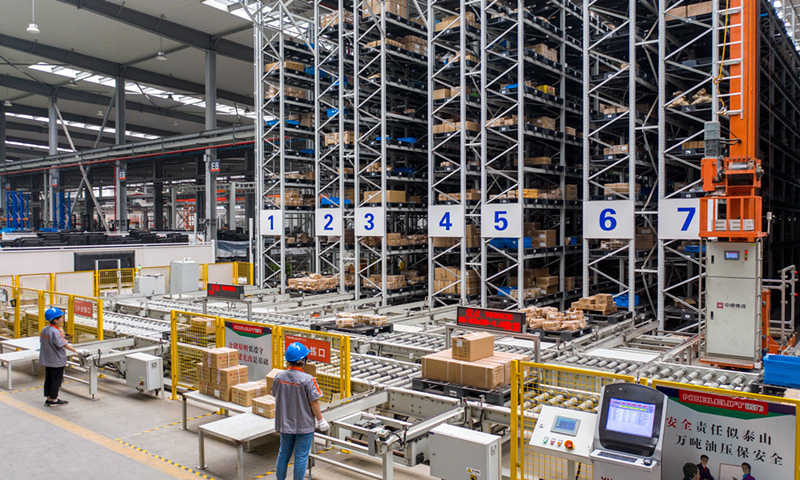
Network maintenance staffers at the local subsidiary of China Mobile in Tongling, East China's Anhui Province test antennas for 5G base stations on December 13, 2021. As of early December, the Tongling subsidiary had built over 650 5G stations, enabling full coverage in Tongling's rural hot spots. Photo: cnsphoto
China rolls out 1.6m 5G base stations, broadband in all rural villages
Nearly 1.6 million 5G base stations have been rolled out in China, making it the first country to build a fairly complete 5G network based on an independent network model, a Chinese official said on Tuesday while marking World Telecommunication & Information Society Day (WTISD) 2022.
"Fixed broadband has been upgraded from 100 megabits per second to 1,000 megabits per second, and the proportion of optical fiber users has increased from less than 10 percent in 2012 to 94.3 percent in 2021," Zhang Yunming, deputy head of the Ministry of Industry and Information Technology, said.
According to Zhang, China has supported the construction of fiber-optic networks in 130,000 villages and 4G base stations in 60,000 villages, raising the rural broadband coverage from less than 70 percent five years ago to 100 percent now.
By February, China had deployed 1.15 million 5G base stations, accounting for some 70 percent of the world's total. All Chinese cities, more than 97 percent of towns and 40 percent of villages in China were covered by 5G networks at that point, according to official data.
Provinces have made plans to raise 5G network coverage rates in rural areas. Southwest China's Yunnan Province, for instance, planned to realize full 5G network coverage in its urban areas by the end of 2023.
Smarter 5G applications cover transportation, medical care, education, culture, tourism, and many other fields in China.

A 5G unmanned delivery car delivers goods at the Beijing Institute of Technology in Beijing, capital of China, April 6, 2020. Photo: Xinhua/Ren Chao
The industrial internet has been applied to 45 major sectors of the economy, covering research and development, design, production and manufacturing, services and other sectors, and the value of the industry has exceeded 1 trillion yuan ($149 billion).

Technicians work at an intelligent stereo warehouse in the Huzhou Economic & Technological Development Zone, East China's Zhejiang Province. The warehouse is equipped with unmanned portable robots, 5G terminals and transmission modules with 5G chips. The facility aims to realize whole-process automation, digitalization and mobile smart production. Photo: VCG
The main forum of WTISD will bring together representatives of major telecom enterprises and upstream and downstream enterprises along the industry chain. They will focus on digital transformation, deeply analyze the implementation of business, and jointly promote a new round of high-quality development centered on the digital economy, according to media reports.
In addition, 11 featured theme forums will focus on 5G and digital economy topics, involving core and key technologies in the process of industry-wide digitalization, such as computing power networks, the Internet of Things, big data, artificial intelligence and digital twins.
WTISD is celebrated annually on May 17 by the International Telecommunication Union (ITU) under the UN to help raise awareness of the possibilities that the use of the internet and other information and communication technologies (ICT) can bring to societies and economies, as well as ways of bridging the digital divide.
This year's theme is digital technologies for healthy aging. According to the UN, the theme raises awareness of the important role of ICTs in supporting people to stay healthy, connected and independent - physically, emotionally and financially.
Supporting a life of healthy aging is also critical for the sustainability of economic and health systems. The aging of the global population will be the defining demographic trend of the 21st century - yet it is hard for our societies to see the opportunities presented by this trend.
Global Times






